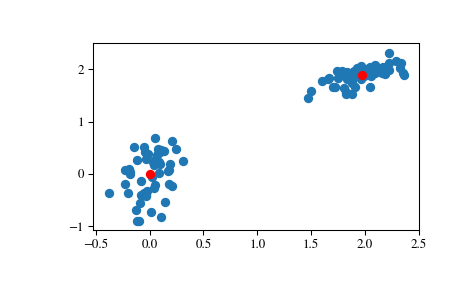scipy.cluster.vq.kmeans¶
-
scipy.cluster.vq.kmeans(obs, k_or_guess, iter=20, thresh=1e-05, check_finite=True)[source]¶ Performs k-means on a set of observation vectors forming k clusters.
The k-means algorithm adjusts the centroids until sufficient progress cannot be made, i.e. the change in distortion since the last iteration is less than some threshold. This yields a code book mapping centroids to codes and vice versa.
Distortion is defined as the sum of the squared differences between the observations and the corresponding centroid.
Parameters: - obs : ndarray
Each row of the M by N array is an observation vector. The columns are the features seen during each observation. The features must be whitened first with the
whitenfunction.- k_or_guess : int or ndarray
The number of centroids to generate. A code is assigned to each centroid, which is also the row index of the centroid in the code_book matrix generated.
The initial k centroids are chosen by randomly selecting observations from the observation matrix. Alternatively, passing a k by N array specifies the initial k centroids.
- iter : int, optional
The number of times to run k-means, returning the codebook with the lowest distortion. This argument is ignored if initial centroids are specified with an array for the
k_or_guessparameter. This parameter does not represent the number of iterations of the k-means algorithm.- thresh : float, optional
Terminates the k-means algorithm if the change in distortion since the last k-means iteration is less than or equal to thresh.
- check_finite : bool, optional
Whether to check that the input matrices contain only finite numbers. Disabling may give a performance gain, but may result in problems (crashes, non-termination) if the inputs do contain infinities or NaNs. Default: True
Returns: - codebook : ndarray
A k by N array of k centroids. The i’th centroid codebook[i] is represented with the code i. The centroids and codes generated represent the lowest distortion seen, not necessarily the globally minimal distortion.
- distortion : float
The distortion between the observations passed and the centroids generated.
See also
Examples
>>> from numpy import array >>> from scipy.cluster.vq import vq, kmeans, whiten >>> import matplotlib.pyplot as plt >>> features = array([[ 1.9,2.3], ... [ 1.5,2.5], ... [ 0.8,0.6], ... [ 0.4,1.8], ... [ 0.1,0.1], ... [ 0.2,1.8], ... [ 2.0,0.5], ... [ 0.3,1.5], ... [ 1.0,1.0]]) >>> whitened = whiten(features) >>> book = np.array((whitened[0],whitened[2])) >>> kmeans(whitened,book) (array([[ 2.3110306 , 2.86287398], # random [ 0.93218041, 1.24398691]]), 0.85684700941625547)
>>> from numpy import random >>> random.seed((1000,2000)) >>> codes = 3 >>> kmeans(whitened,codes) (array([[ 2.3110306 , 2.86287398], # random [ 1.32544402, 0.65607529], [ 0.40782893, 2.02786907]]), 0.5196582527686241)
>>> # Create 50 datapoints in two clusters a and b >>> pts = 50 >>> a = np.random.multivariate_normal([0, 0], [[4, 1], [1, 4]], size=pts) >>> b = np.random.multivariate_normal([30, 10], ... [[10, 2], [2, 1]], ... size=pts) >>> features = np.concatenate((a, b)) >>> # Whiten data >>> whitened = whiten(features) >>> # Find 2 clusters in the data >>> codebook, distortion = kmeans(whitened, 2) >>> # Plot whitened data and cluster centers in red >>> plt.scatter(whitened[:, 0], whitened[:, 1]) >>> plt.scatter(codebook[:, 0], codebook[:, 1], c='r') >>> plt.show()

